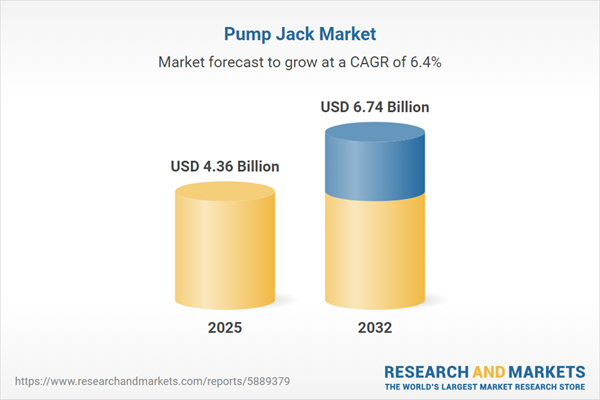Speak directly to the analyst to clarify any post sales queries you may have.
Senior executives are focusing on the pump jack market as an enabler of operational efficiency and sustainable organizational growth. Surging interest is driven by the need for resilient business strategies and technologies capable of supporting ongoing energy transformation in a dynamic sector.
Pump Jack Market Snapshot
The pump jack market continues to advance, propelled by robust demand for artificial lift solutions that maximize output from mature oilfields. The adoption of evolving extraction methods, smarter equipment, and digital integration allows operators to extend asset life and boost workflow efficiency. Pump jacks play a vital role for upstream operations and organizations embracing newer business models. Their capacity to stabilize oil production and support energy transition initiatives enables companies to realign their operational strategies as regulatory demands and competitive pressures evolve. The pump jack market stands as a foundational component anchoring sector advancement and industry adaptability.
Pump Jack Market Scope & Segmentation
This report presents a practical analysis framework designed to help senior decision-makers benchmark competitors, optimize investment strategies, and reinforce business resilience. The following market segments each unlock targeted organizational value and reflect shifting priorities as the competitive environment evolves.
- Power Source: Compare diesel, electric, gas, hydraulic, and solar-powered pump jack systems according to sustainability metrics, energy use, and flexibility across operational settings.
- Application: Review system functionality in onshore and offshore environments to inform project planning and optimize field recovery strategies.
- End User: Address procurement and deployment needs for contract drilling teams, independent operators, land rig contractors, oilfield service providers, and national upstream groups—recognizing the distinct business drivers for each segment.
- Well Depth: Match pump jack technologies to shallow, medium, and deep well scenarios to address unique extraction challenges and facilitate optimal outcomes across complex geological conditions.
- Technology: Analyze the fit of air balanced, conventional beam, and hydraulically balanced models for their compatibility with digital oilfield initiatives and data-driven management practices.
- Geography: Explore market trends, buying patterns, and regulatory nuances across the Americas, Europe, Middle East & Africa, and Asia-Pacific. Emphasize the impact of regional policies and efficient supply chain integration on strategic decision-making.
- Featured Companies: Benchmark offerings from National Oilwell Varco, Schlumberger Limited, Baker Hughes Company, Halliburton Company, Weatherford International plc, Dover Corporation, The Weir Group plc, Jereh Petroleum Equipment Co., Ltd., Jiuzhou Pump Co., Ltd., and Shandong Dongyi Petroleum Equipment Co., Ltd., supporting robust supplier assessments tailored to organizational requirements.
Key Takeaways for Senior Decision-Makers
- Integrating automation and real-time monitoring into pump jack operations supports predictive maintenance strategies, resulting in increased equipment uptime and reduced production risks.
- Transitioning to renewable and low-emission pump jack designs aligns operations with evolving environmental mandates and supports long-term corporate sustainability objectives.
- Leveraging standardized and modular pump jack components improves fleet agility and shortens deployment times, ensuring operational flexibility during routine upgrades or production shifts.
- Staying attuned to regional regulatory dynamics, especially in Asia-Pacific and EMEA, helps maintain compliance and adapt ahead of competitors facing shifting requirements.
- Utilizing remote diagnostics and centralized asset management tools delivers comprehensive oversight, enhancing visibility and resource optimization across dispersed field operations.
- Fostering local workforce development and fortifying regional supply chain partnerships strengthens enterprise resilience and safeguards business continuity amid market change.
Pump Jack Market: Tariff Impact
Recent adjustments in United States tariff policies have elevated the cost of manufacturing and procuring pump jacks for both producers and buyers. To address these changes, stakeholders are expanding domestic collaborations and deepening relationships with local suppliers. These shifts are designed to reduce risk exposure and enhance supply chain reliability in an unpredictable international trade environment.
Methodology & Data Sources
The insights within this report derive from direct engagement with industry leaders, supplier feedback, technical literature reviews, and ongoing analysis of regulatory developments. Experienced sector specialists validate every data point, ensuring senior pump jack market stakeholders receive actionable, thoroughly vetted intelligence.
Why This Report Matters
- Provides executive teams with reliable analysis and actionable recommendations for strategic planning within an evolving pump jack market landscape.
- Addresses contemporary pump jack supply chain challenges and shifting sustainability requirements with practical, industry-aligned solutions.
- Enables detailed supplier comparisons, empowering organizations to meet changing business needs rapidly and confidently.
Conclusion
This report equips senior leaders to optimize pump jack strategies, adapt effectively to industry and regulatory developments, and strengthen their organizations’ resilience amid ongoing energy sector transformation.
Additional Product Information:
- Purchase of this report includes 1 year online access with quarterly updates.
- This report can be updated on request. Please contact our Customer Experience team using the Ask a Question widget on our website.
Table of Contents
3. Executive Summary
4. Market Overview
7. Cumulative Impact of Artificial Intelligence 2025
Companies Mentioned
The companies profiled in this Pump Jack market report include:- National Oilwell Varco, Inc.
- Schlumberger Limited
- Baker Hughes Company
- Halliburton Company
- Weatherford International plc
- Dover Corporation
- The Weir Group plc
- Jereh Petroleum Equipment Co., Ltd.
- Jiuzhou Pump Co., Ltd.
- Shandong Dongyi Petroleum Equipment Co., Ltd.
Table Information
| Report Attribute | Details |
|---|---|
| No. of Pages | 193 |
| Published | October 2025 |
| Forecast Period | 2025 - 2032 |
| Estimated Market Value ( USD | $ 4.36 Billion |
| Forecasted Market Value ( USD | $ 6.74 Billion |
| Compound Annual Growth Rate | 6.4% |
| Regions Covered | Global |
| No. of Companies Mentioned | 11 |









